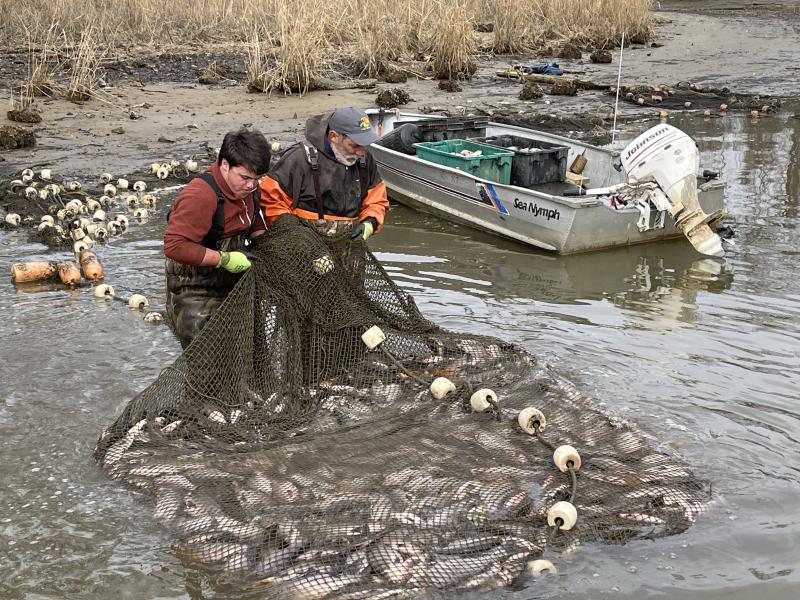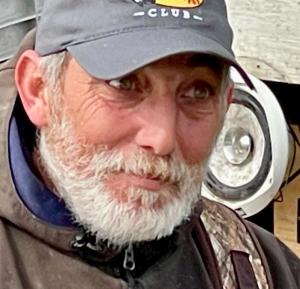Jamie and Jamie Plummer seining mud shad in February
Jamie Plummer and his dad - also Jamie - stand waist deep in their waders in the upper reaches of a narrow creek known as the west fork of Lankford Bay.
This is the upper Chesapeake. Lankford Bay is a tributary off the lower Chester River. The Chester’s headwaters arise in Kent County, Delaware, adjacent to Kent County, Maryland. Just a handful of miles above Millington.
From there, the river forms up out of swampy woods, crosses the state line and flows dozens of miles southwestward into the Chesapeake, just above the bay bridge.
Two shallow-draft workboats flank the father-son Plummer team. The men straddle soggy loops of an 1,100-foot cork-floated haul seine. The bunt of the seine, a netted bag in its center for gathering the catch, pulses with what Jamie Sr. estimates is a ton of glistening mud shad. Hundreds of them. Also known as gizzard shad.
These early spawners are headed up the fork to a dam near the historic Episcopal church known as Old St. Paul’s. The waters of the mill pond above the dam reflect the brick structure, its generations of tombstones, and old cedars.
But Jamie and Jamie aren’t interested in the dead. Their goal on this full moon-eve day at the end of February is making a living.
Raym and I came upon the watermen while heading up the fork to hook late winter yellow perch starting their own spawning runs. Raym calls them yellow neds. Good eating panfish.
Not so with the mud shad, unless you're a Louisiana crawdad. “They’re not fit for people to eat,” says Jamie senior. But, he says, their catch will be trucked south where they are highly valued as bait for the traps used to catch crawdads.
Like a freshwater shrimp, crawdads are a southern culinary tradition. People love them. Steamed, boiled, seasoned. When local watermen discovered there is an eager market for the mud shad, it turned a formerly nuisance, seasonal fish into another way to make money.
P.T Hambleton, a seafood broker in Bozman, west of St. Michaels, Md., says the oily mud shad at this time of the year bring more money than rockfish. “It’s all about supply and demand,” he says. “It’s the bait they want down there. You never know what’s going to be valued in nature from one year to the next.”
Long before Raym and I came upon the Jamies, they had tied one end of their seine to a thick-trunked tree on one bank of the creek. Then they pulled their seine across the creek against the ebbing tide to catch outbound fish. With the net bowed across the creek, they stood on its weighted bottom edge to keep fish from swimming beneath it.
It worked. The fish, most of them mud shad, swam down the wings of the seine into the bag. Mixed in with them were one or two tiger-striped yellow perch, some coy and carp, a few black catfish.
“When we’re catching catfish we know we’ve kept it on the bottom,” said Jamie senior.
After sorting through the fish to throw away those of no value, and securing the shad in the bunt, the Jamies took our arrival as time for a break and chatter.
Raym asked Jamie the younger what he planned to be doing in the years ahead.
“Not this,” he said. “I want a job with benefits.”
“I don’t want this for him either,” said Jamie senior. “Look at us out here, standing in 35-degree water in the middle of winter.”
“You don’t see that as a benefit?” I asked Jamie junior. He just smiled and shook his head.
Then Jamie senior talked about the good money he has made through the years catching snapping turtles in baited circle nets, blue crabs in pots and on trotlines, oysters, and in most recent years, unexpected opportunities like mud shad and praying mantis cocoons.
“Praying mantis cocoons? Where’s there a market for those,” I asked.
“Wineries,” said Jamie senior. “They want all they can get. Pay 75 cents apiece.”
Jamie junior jumped in.
“I know a boy who made $225 with a day’s worth of cocoons.”
Apparently wineries - especially the ones with organic vineyards - can’t use pesticides so they import praying mantis to take care of the job naturally.
“But you have to be careful with them,” said Jamie senior. “One cold day I had a bunch in my car with the heater on. The next thing I knew I had tiny little hatching praying mantises all over the inside of the windshield.”
Raym asked Jamie senior if he wouldn't rather be in a warm office somewhere poring over spreadsheets, trying to figure out new standards and how best to meet quotas?
Standing waist-deep in the muddy creek alongside a net bulging with thousands of dollars worth of fish, senior didn’t hesitate. “Outside like this in a beautiful part of the world? No one but myself to answer to.? Even in this 35-degree water, I wouldn’t trade this for anything,” he said.
Benefits, like beauty apparently, are in the eye of the beholder.























































